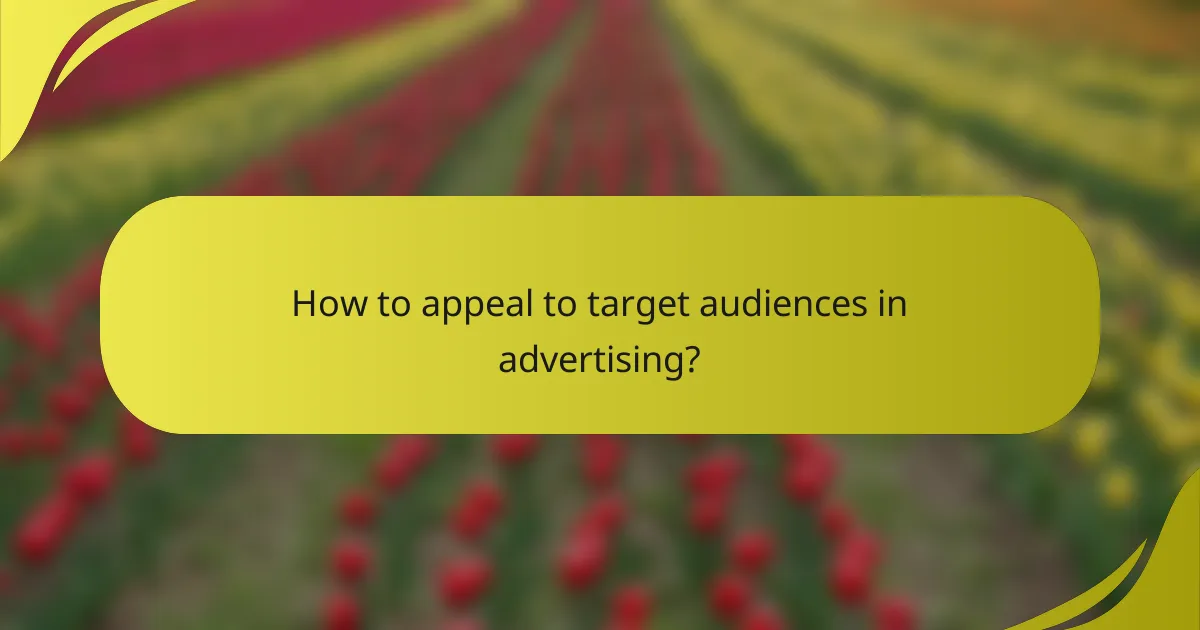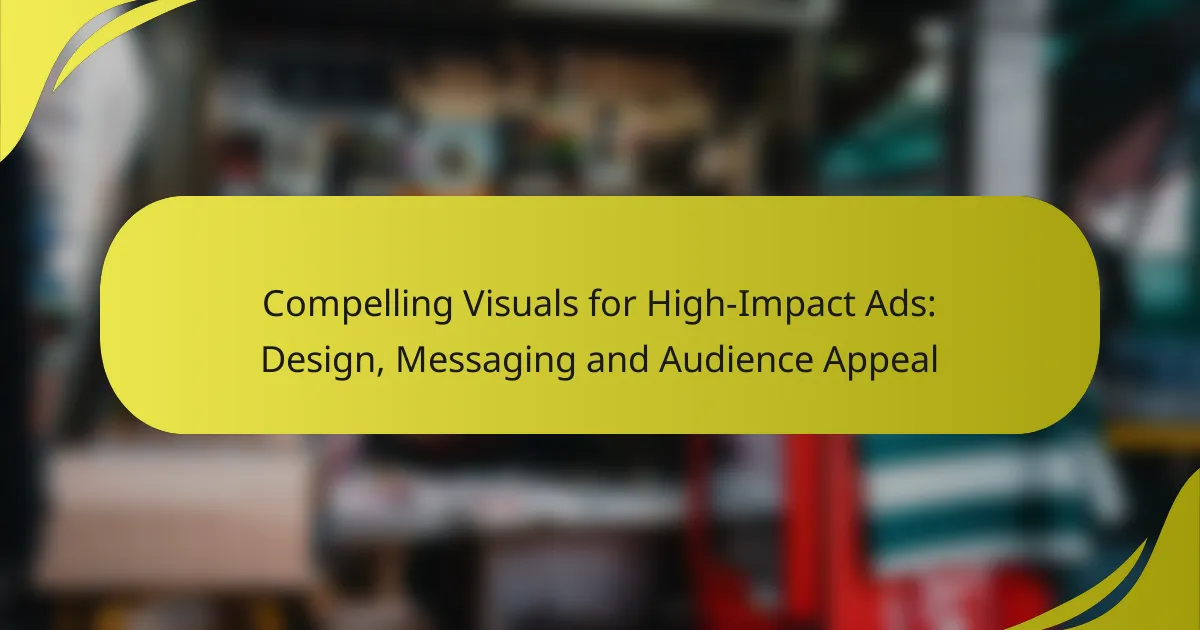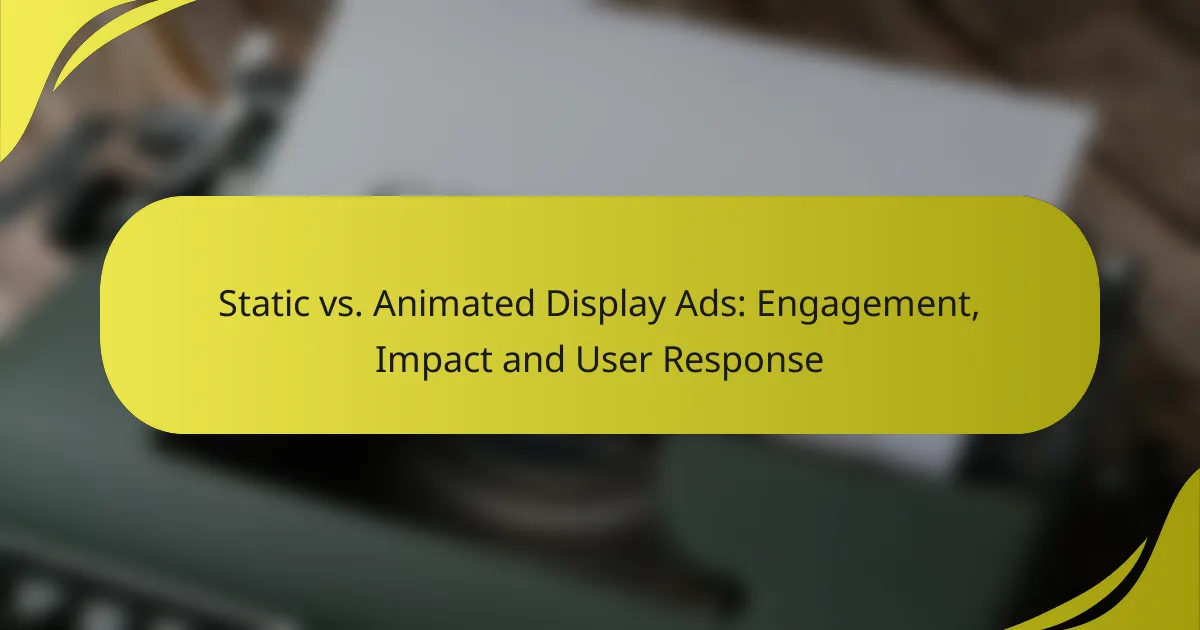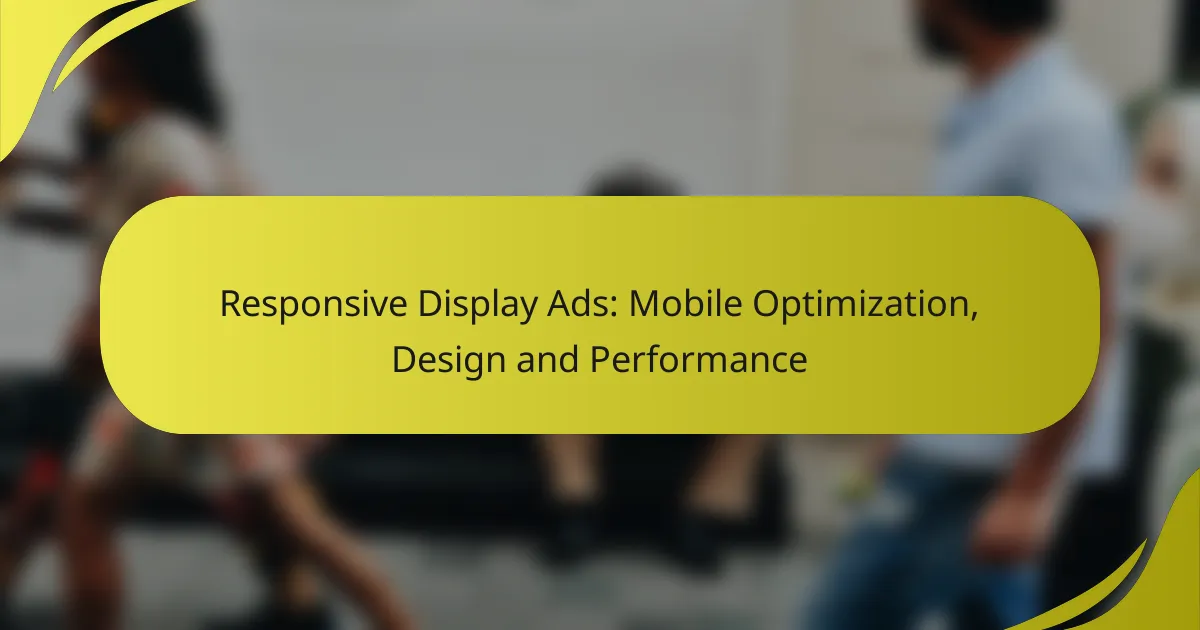Creating compelling visuals for high-impact ads requires a strategic blend of high-quality imagery, effective color schemes, and engaging typography that together capture attention and convey your message. By understanding your target audience’s values and preferences, you can craft resonant messaging that evokes emotions and highlights unique benefits. Tailoring both visuals and messaging to meet the specific needs of your demographic is essential for maximizing engagement and driving conversions.

How to create compelling visuals for display ads?
Creating compelling visuals for display ads involves using high-quality images, effective brand colors, engaging typography, clear visual hierarchy, and motion graphics. These elements work together to capture attention and communicate your message effectively.
Use high-quality images
High-quality images are essential for making a strong impression in display ads. They should be clear, well-composed, and relevant to your message. Aim for images that are at least 1200 pixels wide to ensure they look sharp on various devices.
Consider using stock photos or custom photography that aligns with your brand’s identity. Avoid blurry or pixelated images, as they can detract from your ad’s credibility and effectiveness.
Incorporate brand colors
Using your brand colors consistently helps reinforce brand recognition and creates a cohesive look across your advertising materials. Choose a color palette that reflects your brand’s personality and resonates with your target audience.
Limit your palette to two or three primary colors to avoid overwhelming viewers. Use contrasting colors for text and backgrounds to enhance readability and draw attention to key elements.
Utilize engaging typography
Typography plays a crucial role in conveying your message and establishing your brand’s tone. Select fonts that are legible and align with your brand’s style. Sans-serif fonts are often preferred for digital ads due to their clarity.
Limit the number of different fonts to two or three to maintain visual harmony. Ensure that your text size is large enough to be easily read on smaller screens, typically at least 14-16 pixels for body text.
Implement visual hierarchy
Visual hierarchy guides viewers through your ad by emphasizing the most important elements. Use size, color, and placement to create a clear order of information. The most critical message should be the most prominent.
Consider using larger fonts for headlines and smaller ones for supporting text. Position key visuals and calls to action in areas where the eye naturally falls, such as the center or top of the ad.
Leverage motion graphics
Motion graphics can significantly enhance the appeal of display ads by adding dynamism and attracting attention. Simple animations, such as text transitions or image slides, can make your ad more engaging without overwhelming the viewer.
Be mindful of the file size and loading times, as heavy animations can slow down page performance. Aim for short, subtle movements that complement your message rather than distract from it.

What messaging resonates with audiences?
Messaging that resonates with audiences typically evokes emotions, highlights unique benefits, and provides clear actions. Understanding your target demographic’s values and preferences is crucial for crafting effective messages that engage and motivate them.
Focus on emotional triggers
Emotional triggers play a significant role in advertising by creating connections with the audience. Ads that evoke feelings such as happiness, nostalgia, or empathy can enhance recall and foster brand loyalty. For instance, a campaign that tells a heartfelt story about family can resonate deeply with viewers.
To effectively leverage emotional triggers, identify the core emotions that align with your brand values and audience expectations. Use visuals and narratives that reflect these emotions, ensuring they are authentic and relatable.
Highlight unique selling propositions
Unique selling propositions (USPs) differentiate your product or service from competitors. Clearly articulating what makes your offering special can capture attention and drive interest. For example, if your product is eco-friendly, emphasize its sustainability benefits to attract environmentally conscious consumers.
When highlighting USPs, focus on clarity and relevance. Use straightforward language and visuals that reinforce your message. Consider creating a comparison table that outlines your product’s features against competitors to illustrate its advantages effectively.
Use clear calls to action
Clear calls to action (CTAs) guide audiences on what steps to take next, making them essential in high-impact ads. Phrases like “Shop Now,” “Sign Up Today,” or “Learn More” should be prominent and compelling. A well-placed CTA can significantly increase conversion rates.
Ensure your CTAs are visually distinct and strategically positioned within your ad. Test different wording and placements to find what resonates best with your audience. Avoid vague language and be specific about the benefits of taking action, such as “Get 20% off your first purchase.”

How to appeal to target audiences in advertising?
To effectively appeal to target audiences in advertising, it is crucial to understand their preferences, behaviors, and needs. Tailoring your messaging and visuals to resonate with specific demographics enhances engagement and conversion rates.
Conduct audience segmentation
Audience segmentation involves dividing your target market into distinct groups based on shared characteristics such as demographics, interests, or purchasing behavior. This process allows advertisers to create more personalized and relevant campaigns that speak directly to each segment’s unique needs.
For example, a clothing brand might segment its audience into categories like age, gender, and lifestyle. By doing so, they can design targeted ads that showcase styles appealing to each specific group, increasing the likelihood of engagement.
Utilize A/B testing for feedback
A/B testing, or split testing, is a method where two versions of an advertisement are compared to determine which performs better. By testing different visuals, messaging, or calls to action, advertisers can gather data on audience preferences and optimize their campaigns accordingly.
For instance, an ad with a bold headline might be tested against one with a more subtle approach. Analyzing the response rates can reveal which style resonates more with the target audience, allowing for informed adjustments in future campaigns.
Analyze competitor strategies
Understanding competitor strategies is essential for identifying market trends and gaps. By analyzing how competitors engage their audiences, advertisers can gain insights into effective messaging, design elements, and promotional tactics that resonate with similar target groups.
For example, if a competitor’s ad campaign successfully utilizes vibrant colors and emotional storytelling, you might consider incorporating similar elements while ensuring your brand maintains its unique voice. This approach can help you stand out while still appealing to shared audience interests.

What design principles enhance ad effectiveness?
Effective ad design relies on principles that capture attention, convey messages clearly, and resonate with the target audience. Key design elements include visual balance, clarity, and adaptability to various platforms.
Apply the rule of thirds
The rule of thirds is a compositional guideline that divides an image into nine equal parts, using two horizontal and two vertical lines. Placing focal points along these lines or at their intersections creates a more engaging visual experience. This technique helps draw the viewer’s eye to important elements, enhancing overall impact.
For example, in a product ad, position the product at one of the intersections while placing supporting text or imagery along the lines. This arrangement can significantly improve viewer engagement and retention.
Ensure mobile responsiveness
With a significant portion of users accessing ads on mobile devices, ensuring mobile responsiveness is crucial. This means designing ads that automatically adjust to different screen sizes without losing clarity or impact. Responsive design enhances user experience and increases the likelihood of interaction.
Consider using scalable vector graphics (SVG) and flexible layouts to maintain quality across devices. Test ads on various screen sizes to ensure that text is legible and images are clear, avoiding any elements that may become distorted or misaligned.
Maintain consistency across platforms
Consistency in design across various platforms strengthens brand recognition and trust. Use the same color schemes, fonts, and imagery styles to create a cohesive look that users can easily identify, whether they encounter your ad on social media, websites, or email.
Establish a style guide that outlines these elements and ensures all team members adhere to it. Regularly review ads across platforms to ensure they align with your brand’s visual identity, making adjustments as necessary to maintain a unified presence.

What tools can help in ad design?
Several tools can significantly enhance ad design by providing powerful features for creating compelling visuals. These tools range from comprehensive software suites to specialized applications, catering to different aspects of design, messaging, and audience engagement.
Adobe Creative Suite
Adobe Creative Suite is a leading collection of design tools that includes Photoshop, Illustrator, InDesign, and more, making it ideal for creating high-impact ads. Each application serves a specific purpose, such as image editing, vector graphics, or layout design, allowing designers to produce professional-quality visuals.
When using Adobe Creative Suite, consider the learning curve associated with each tool. Beginners may find Photoshop and Illustrator more intuitive, while InDesign is excellent for multi-page layouts. Investing time in tutorials can greatly enhance your proficiency and efficiency.
For effective ad design, leverage Adobe’s extensive library of templates and stock images. These resources can save time and inspire creativity. Additionally, ensure your designs align with your brand guidelines, maintaining consistency across all advertising platforms.



